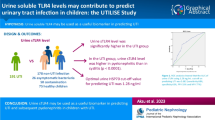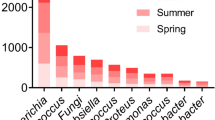Abstract
This study was designed to determine whether the measurement of interleukin (IL)-6 in urine is useful for distinguishing between acute pyelonephritis and lower urinary tract infection. This observational study was carried out at León Hospital (Spain) on 35 patients (ten boys) aged between 0 and 14 years with urinary tract infection. Urinary levels of IL-6 were determined with enzyme-linked immunosorbent assay (ELISA) at diagnosis and after recovery. Renal dimercaptosuccinate acid (DMSA) scan was performed on all patients to discard or confirm acute pyelonephritis. The mean urinary concentration [x ± standard deviation (SD)] of IL-6 at diagnosis was 20.3 ± 23.3 and 5.3 ± 9.7 pg/ml in patients with acute pyelonephritis and lower urinary infection, respectively [95% confidence interval (CI): 2.6–27.4; p < 0.01]. Specificity for a value of IL-6 >15 pg/ml, was 94.1% (95% CI: 91.1–97.1). Positive predictive value for IL-6 >15 pg/ml was 87.5% (95% CI: 81.1–93.8). IL-6 was undetectable in the urine of both groups of patients at the time of recovery. Urinary levels of IL-6 are useful in differentiating between upper and lower urinary tract infection in children. In this clinical setting, a value >15 pg/ml is a strong indicator of acute pyelonephritis.

Similar content being viewed by others
References
Hellerstein S (2006) Acute urinary tract infection - evaluation and treatment. Curr Opin Pediatr 18:134–138
Alper BS, Curry SH (2005) Urinary tract infection in children. Am Fam Physician 72:2483–2488
Jenicek M (1996) La terapéutica y otras intervenciones clínicas y de salud pública, 1st ed. Masson, Barcelona, pp219–255
Mak RH, Kuo HJ (2006) Pathogenesis of urinary tract infection: an update. Curr Opin Pediatr 18:148–152
Jahnukainen T, Chen M, Celsi G (2005) Mechanisms of renal damage owing to infection. Pediatr Nephrol 20:1043–1053
Robles B, Rodríguez LM, Suárez MA, Marugan JM, Fernández M, Fuentes MC (2005) Comparación de la utilidad de la fiebre y de algunos parámetros analíticos para el diagnóstico de pielonefritis aguda en niños. Rev Esp Pediatr 61:358–363
Ataei N, Madani A, Habibi R, Khorasani M (2005) Evaluation of acute pyelonephritis with DMSA scans in children presenting after the age of 5 years. Pediatr Nephrol 20:1439–1444
Shah G, Upadhyay J (2005) Controversies in the diagnosis and management of urinary tract infections in children. Paediatr Drugs 7:339–346
Godaly G, Otto G, Burdick MD, Strieter RM, Svanborg C (2007) Fimbrial lectins influence the chemokine repertoire in the urinary tract mucosa. Kidney Int 71:778–786
Gurgoze MK, Akarsu S, Yilmaz E, Godekmerdan A, Akca Z, Ciftci I, Aygun AD (2005) Proinflammatory cytokines and procalcitonin in children with acute pyelonephritis. Pediatr Nephrol 20:1445–1448
Rodríguez LM, Marugán JM, Suárez MA, Torres MC (2003) Citoquinas en la patología nefrourológica pediátrica. Arch Latin Nefr Ped 3:73–81
Funfstuck R, Franke S, Hellberg M, Ott U, Knöfel B, Straube E, Sommer M, Hacker J (2001) Secretion of cytokines by uroepithelial cells stimulated by Escherichia coli and citrobacter spp. Int J Antimicrob Agents 17:253–258
Marugán JM, Suárez MA, Rodríguez LM, García JM (2005) Niveles normales de interleucinas 6 y 8 en suero y orina de niños sanos asintomáticos. Bol Pediatr 45:177–184
Benson M, Jodal U, Agace W, Hellström M, Mårild S, Rosberg S, Sjöström M, Wettergren B, Jönsson S, Svanborg C (1996) Interleukin (IL)-6 and IL-8 in children with febrile urinary tract infection and asymptomatic bacteriuria. J Infect Dis 174:1080–1084
Tullus K, Fituri O, Linne T, Escobar-Billing R, Wikstad I, Karlsson A, Burman LG, Wretlind B, Brauner A (1994) Urine interleukin-6 and interleukin-8 in children with acute pyelonephritis, in relation to DMSA scintigraphy in the acute phase and at 1-year follow-up. Pediatr Radiol 24:513–515
Jantausch BA, O'Donnell R, Wiedermann BL (2000) Urinary interleukin-6 and interleukin-8 in children with urinary tract infection. Pediatr Nephrol 15:236–240
Roilides E, Papachristou F, Gioulekas E, Tsaparidou S, Karatzas N, Sotiriou J, Tsiouris J (1999) Increased urine interleukin-6 concentrations correlate with pyelonephritic changes on 99mTc-dimercaptosuccinic acid scans in neonates with urinary tract infections. J Infect Dis 180:904–907
Espinosa L (2006) Infección urinaria. In: Garcia Nieto V, Santos F, Rodríguez Iturbe B (eds) Nefrología Pediátrica, 2th ed. Aula Médica, Madrid, pp 507–520
Harbert JC, Eckelman WC, Neumann RD (1996) Nuclear medicine, diagnosis and therapy, 1st edn. Thieme Medical, New York, pp 713–743
Patel K, Charron M, Hoberman A, Brown ML, Rogers KD (1993) Intra and interobserver variability in interpretation of DMSA scans using a set of standardized criteria. Pediatr Radiol 23:506–509
Ochoa Sangrador C, Orejas G (1999) Epidemiología y metodología científica aplicada a la pediatría (IV): Pruebas diagnósticas. An Esp Pediatr 50:301–314
Jenicek M (1996) La terapéutica y otras intervenciones clínicas y de salud pública, 1st ed. Masson, Barcelona, pp79–122
Epi Info [computer program] (2002) Atlanta, Centers for Disease Control and Prevention
Epidat 3.1 para Windows (2004) Análisis Epidemiológico de Datos Tabulados. Programa desarrollado por la Xunta de Galicia y la Organización Panamericana de la Salud
Carrasco JL (1995) El método estadístico en la investigación médica, 6th ed. Ciencia 3, Madrid, pp 45–122
Carrasco JL (1995) El método estadístico en la investigación médica, 6th ed. Ciencia 3, Madrid, pp 127–227
Yang H, Carlin D (2000) ROC surface: a generalization of ROC curve analysis. J Biopharm Stat 10:183–196
Sheu JN, Chen MC, Lue KH, Cheng SL, Lee IC, Chen SM, Tsay GJ (2006) Serum and urine levels of interleukin-6 and interleukin-8 in children with acute pyelonephritis. Cytokine 36:276–282
Webb NJ, Brenchley PE (2004) Cytokines and cell adhesion molecules in the inflammatory response during acute pyelonephritis. Nephron Exp Nephrol 96:1–6
Krzemien G, Roszkowska-Blaim M, Kostro I, Szmigielska A, Karpińska M, Sieniawska M, Bart3omiejczyk I, Paczek L, Toth K (2004) Urinary levels of interleukin-6 and interleukin-8 in children with urinary tract infections to age 2. Med Sci Monit 10:CR 593–CR 597
Acknowledgments
This work was supported by grant FIS 97/1125 from Carlos III Institute, Spanish Ministry of Health. This work was partially presented at the 13th Congress of the International Paediatric Nephrology Association, Adelaide, Australia, 2004.
Conflict of interest statement
None of the authors have any commercial or other association that might pose a conflict of interest.
Author information
Authors and Affiliations
Corresponding author
Rights and permissions
About this article
Cite this article
Rodríguez, L.M., Robles, B., Marugán, J.M. et al. Urinary interleukin-6 is useful in distinguishing between upper and lower urinary tract infections. Pediatr Nephrol 23, 429–433 (2008). https://doi.org/10.1007/s00467-007-0670-4
Received:
Revised:
Accepted:
Published:
Issue Date:
DOI: https://doi.org/10.1007/s00467-007-0670-4




